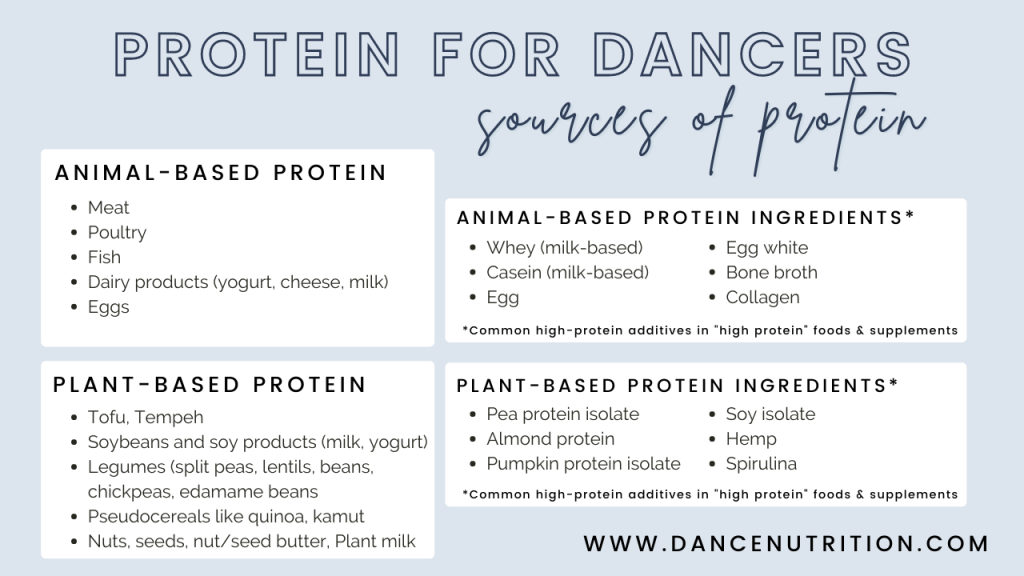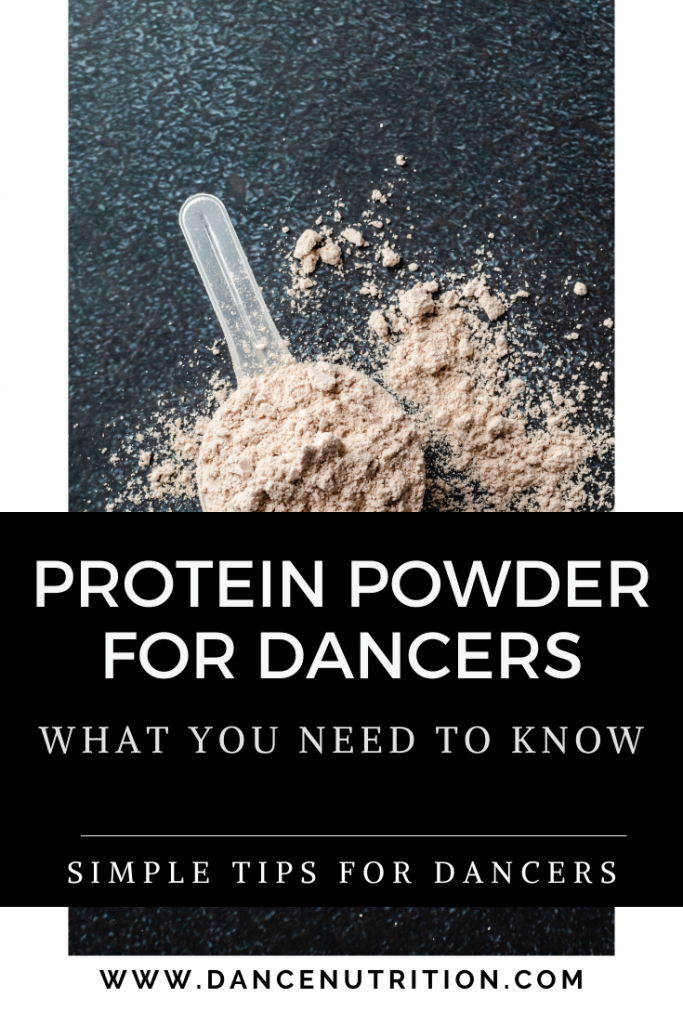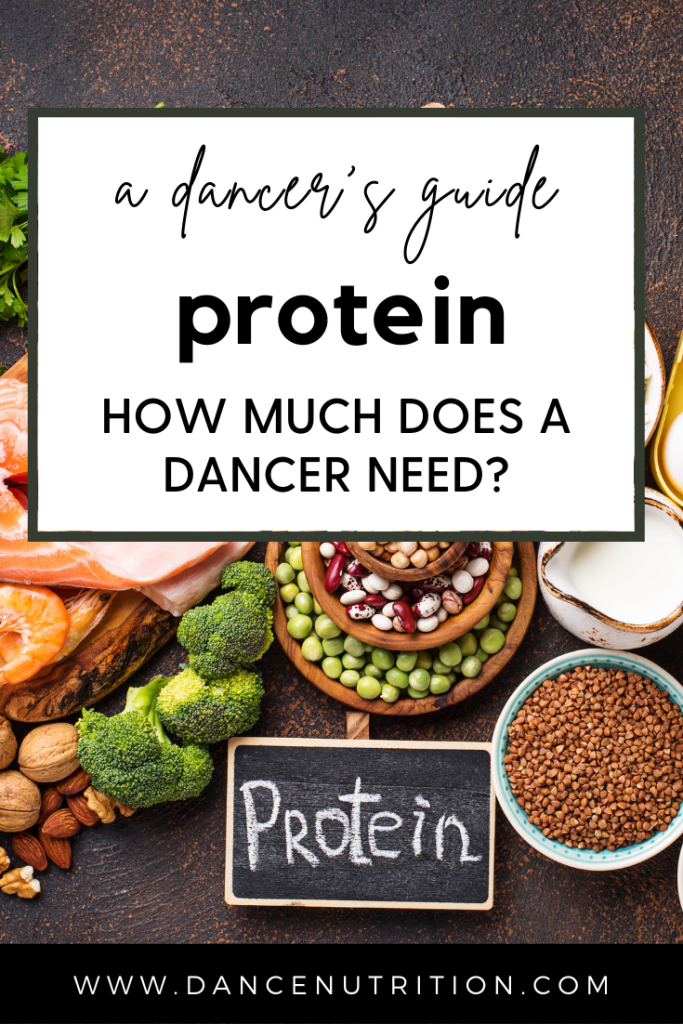Protein is an essential nutrient for dancers, most notable is the role of protein in rebuilding and repairing muscle tissue. To learn more about this star macronutrient, check out this blog post. But how about protein supplements? While research supports the benefits of protein after exercise as it stimulates muscle protein synthesis, no evidence supports the use of protein powders, as a replacement for food, to enhance muscular response to training.
Should dancers add protein powder to their diet?
Generally, a food-first approach is encouraged as supplements are both questionable (from a safety perspective) and oftentimes, expensive. You can read more about the safety concerns of the supplement industry here. If you’re already consuming ample protein from the foods in your diet, then supplements are not needed.
But in some instances, protein powders (and other protein supplements like protein bars) can be a reliable way to support a dancer’s recovery. When combined with training, protein supplements can support strength gains. But it’s important to note that these benefits are also seen with the inclusion of high-protein foods into one’s diet. So, if busy schedules make it tough to incorporate adequate amounts of protein-rich foods throughout the day, then supplements can help. And last, some question whether or not extra protein helps to maintain muscle mass when you’re not able to dance (like if you’re recovering from an injury), but the research is mixed.
How much protein powder is too much?
There is a common myth that the body can only absorb and utilize 20 grams of protein at one time. But this is not necessarily true. The amount of protein that a dancer’s body absorbs in one sitting will depend upon their individual needs but is thought to be around 30 grams. We also know that to optimally stimulate muscle growth, it’s best to divide your protein intake across multiple meals and snacks throughout the day and for athletes, there might be a benefit to consuming protein within the hour after intense exercise as a way to optimize muscle recovery. But keep in mind that much of the research in this area is performed either on older adults or athletes, not dancers. While not ALL of the protein in your meal will be utilized for muscle building, some can be used for other purposes like building hormones, enzymes, and antibodies.
Protein supplements: considerations
In regard to your options, there are countless! First, consider whether or not you’d like a plant-based or animal-based protein powder. From there, you’ll want to consider if other additives are included. Keep in mind that protein powders contain sweetener alternatives (stevia, monk fruit extract), artificial sweeteners, or sugar alcohols (erythritol, xylitol, maltitol) & synthetic fibers (inulin, chicory root). These ingredients can cause stomach upset and discomfort for some dancers so you’ll want to either opt out of these options, or trial small quantities (such as half a serving) at a time.
Common Plant-Based Protein Additives:
- Pea protein isolate
- Almond protein
- Peanut protein
- Pumpkin protein isolate
- Soy isolate
- Hemp protein
- Spirulina
Common Animal-Based Protein Additives:
- Whey (milk-based)
- Casein (milk-based)
- Egg
- Egg white
- Bone broth
- Collagen

Which protein powder is best?
Both animal and plant proteins can provide beneficial effects on recovery. Let’s compare:
Whey Protein
Whey is the most common protein supplement on the market. It’s considered a “complete” protein as it contains all essential amino acids, along with the highest percentage of branched-chain amino acids (BCAAs). BCAAs have been known to be depleted after intense exercise so a supplement rich in these essential amino acids might be helpful. Unlike most protein powders, whey protein is also high in leucine, an amino acid that stimulates muscle protein synthesis and might be the most efficiently utilized when compared to other protein types.
Collagen
Collagen is another popular protein supplement that is often marketed for joint and skin health. Collagen is the most abundant protein in the human body― it’s a building block for skin, hair, tendons, cartilage, bones, and tissues. As we age, our bodies produce less collagen― a natural response to aging (hello wrinkles). This is why collagen is often marketed as a supplement to fight the aging process. One popular source of collagen in our diet is bone broth.
In regard to the research, it’s mixed. Some small studies have drawn associations between collagen with outcomes like skin hydration and elasticity. But these studies are often limited in time and bias (many are conducted by the companies selling the supplements). Marketing around collagen supplementation is even more interesting because it often focuses on the very side effects experienced from disordered eating― brittle nails and hair, bone health, and joint pain. But again, the evidence remains limited (and practically nonexistent).
Collagen is not considered a complete protein. This means that, unlike whey or soy protein, a collagen supplement won’t provide us with all essential amino acids. Without needing to rely on expensive supplementation, we can incorporate a variety of foods that contain specific nutrients known to help boost our body’s natural production of collagen. Zinc, vitamin C, and copper all act as cofactors in the production of collagen. Also, avoiding behaviors that damage naturally occurring collagen (like smoking and excessive sun exposure) can help. If your concerns are bone health and pain-free joints, then you’ll want to consult with a licensed medical provider who can help to identify other more supportive treatments (and don’t be surprised… it could be to start with healing your relationship with food).
Soy Protein
When compared to other plant-based protein powders, soy protein is a complete protein that contains all essential amino acids. Studies show that both whey and soy protein supplementation lead to similar results in regard to muscular response. In regard to hormones, there is some research suggests that those with a predisposition to thyroid dysfunction should limit their consumption of soy-based protein.
Rice Protein
Rice protein has been compared to whey protein with both resulting in improvements in muscle strength and performance. But since rice on its own doesn’t contain all essential amino acids, it’s important that this not make up the majority of one’s protein each day.
Pea Protein
Similar to soy, pea protein is a complete protein and rich in essential BCAAs. However, there is some evidence to suggest that pea protein might be less utilized by the body when compared to other types. But realize, this is not enough to warrant avoidance of pea protein, especially when it’s only part of one’s overall daily intake.
Hemp Protein
First, let me clear the air, hemp protein does not have the same psychoactive properties as marijuana. One of the main proteins in hemp is albumen, the same protein found in egg whites and is rich in all essential amino acids. But research remains limited on the benefits of hemp protein with no conclusive findings to date.
Peanut Protein and Almond Protein
Although peanuts contain all essential amino acids, it’s low in one. However, this is generally not a concern as the concentration of this amino acid is abundant elsewhere in the average human diet. So, these options can still be utilized as supplemental protein sources as long as allergies do not exist
What should dancers consider?
For non-plant-based dancers, whey protein is likely your best bet. For plant-based dancers, consider a protein powder that contains a blend of different plant-based proteins (ie. soy protein/brown rice protein blend) might be beneficial to gain a broader spectrum of essential amino acids. Or, be sure that your protein supplementation (like pea, almond, or peanut) is not your ONLY source of protein for the day. You can utilize this to increase the protein content of your smoothie by adding a protein powder that contains at least 20 grams per serving. But it’s just a fraction of your overall daily food intake.
Key takeaway:
Protein from supplements can add up quickly if you’re relying heavily on eating bars, shakes, and powders. Though sometimes helpful (especially in circumstances like this), protein powders shouldn’t replace opportunities for food. Utilizing a food-first approach is always encouraged and will be your most economical option long term. Eating a variety of protein-rich foods throughout the day (such as beans, lentils, poultry, fish, eggs, yogurt, nuts, and seeds) can meet a dancer’s protein needs without having to rely on expensive supplements. If you are considering a supplement, choose a third-party tested plant or whey protein powder and aim for no more than one supplement per day or a few per week.





